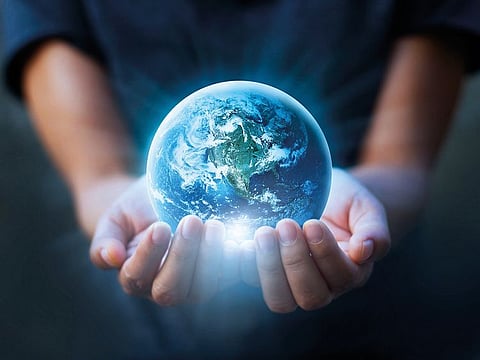Readers' Letters: Importance of global forest restoration, Earth Hour shows the power of saving energy
Readers discuss community issues around the world

Restoring forests
March 21 is the International Day of Forests worldwide (“In Pictures: Sharjah developer Arada is connecting with nature - building a ‘forest’ is the way to do it”, Gulf News, October 12). The United Nations Forest and Agriculture Organisation has declared this as a day to celebrate how forests and trees sustain and protect us. Interacting with nature and forests is a crucial part of human health and life, and we need to continue working towards maintaining the wellbeing of our natural environments. It is a day to reflect and remind us how vital forests and trees are to the Earth. Forests are the most biologically diverse terrestrial ecosystems and cover one-third of the Earth’s landmass. They are home to more than 80 per cent of plants and animals’ land species and help balance the air’s oxygen, carbon, and humidity. Forests are also beautiful, and an Earth without them would be uninhabitable. What better time to raise awareness of the importance of forests and trees than now? It’s the perfect time to discover ways to give back to the environment and work towards a healthier neighbourhood, city, country, and planet. Rather than helping to combat the climate crisis at a time most needed, our forests are increasingly victims of it. Healthy forests mean healthy, resilient communities and prosperous economies. Growing trees, greening cities, rebuilding gardens, changing diets or cleaning up rivers and coasts. I believe this generation can make peace with nature, and it’s high time we should focus on that part. We humans should pledge ourselves to preserve and protect what is left.
From Mr Gobind Shankar
India
How to live a sustainable lifestyle
Living a sustainable life should be a routine (“7 tips to help your child live a sustainable life”, Gulf News, February 22). Gradually, it becomes your lifestyle. From food, clothes, and furniture in your house, there are a lot of aspects to living a sustainable life. Reduce, reuse, repair and only then, recycle.
Try to reuse things more often. Apply this in your daily life and you will automatically switch to a sustainable lifestyle. Reduce plastic usage, reuse your grocery bag, take a reusable water bottle to the office. If your shoe is a little damaged, try to repair it. Good quality clothing can last up to five years; reuse and fix whatever possible. I’ve started prioritising buying second-hand products to reduce the amount of waste that I create. However, when I have to order something brand new, I use tools like EcoCart, a Chrome Extension that make my order carbon neutral. It’s free and super easy to install.
Making small changes like these will have you on your way to a more sustainable life in no time. A significant component of the idea of living a sustainable lifestyle is not something you have to accomplish all in one go, but rather something you can achieve gradually through minor changes in the way you live.
From Mr Akhil B
Ajman, UAE
The power of saving energy
Earth hour is a great initiative, and this year we observe it on March 27 from 8.30 to 9.30pm (“Earth Hour: Why humanity must see the light in the darkest hour of facing COVID-19”, Gulf News, March 26). This year’s theme shapes our future, which is more relevant for people and the future. It is the 15th consecutive year we are celebrating. With each year passing, it is gaining momentum and millions of people are joining. As usual at home, we will switch off all electronic gadgets and make our children understand and learn more about saving energy and the importance of this day. For me, every hour should be Earth Hour in a way. We usually switch off unnecessary lights, minimise the use of electronic gadgets, and contribute to this cause. This awareness will develop a new culture to conserve energy, preserve natural resources, and protect our environment. This should be a part of our daily lives and protect our mother earth for future generations.
From Mr Eappen Elias
Dubai
Cricket: ICC Women’s World Cup
It is a proud moment for the fans of Indian women’s cricket that two stalwarts have set a new world record in cricket. Indian cricket captain Mithali Raj has led the team for a grand total of 24 World Cup games, surpassing Belinda Clark of Australia with 23 matches and Jhulan Goswami. By capturing her 40th wicket in World Cup games, she has exceeded the record of Australian Lynette Fullston, who took 39 wickets during her career as an all-time highest wicket-taker in the history of ICC Women’s World Cup. Both should add to these records in the remaining matches. The win over West Indies at Hamilton, with a massive margin of 155 runs, enabled the Indian team to take to the top of the points table. Thanks to Smriti Mandhana and Harmanpreet Kaur, who stitched an Indian record of 184 runs highest partnership for any wicket at the Women World Cup Tournament. Well done, Women In Blue. Keep it up till the finals.
From Ms Kavitha Srikanth
Tamil Nadu, India
Editor’s note: Is there a news report that you feel strongly about? Something that has to be addressed in the community and requires resolution? Email us on readers@gulfnews.com. You can also post a comment on our Facebook page or tweet to us @GNReaders
Sign up for the Daily Briefing
Get the latest news and updates straight to your inbox



